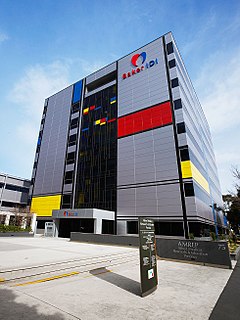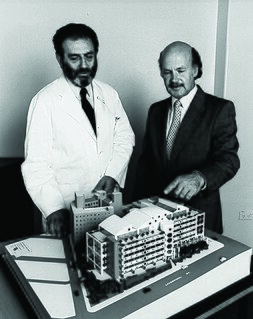Related Research Articles

A medical laboratory scientist (MLS) or clinical laboratory scientist (CLS) or medical technologist (MT) performs diagnostic testing of blood and body fluids in clinical laboratories. The scope of a medical laboratory scientist's work begins with the receipt of patient or client specimens and terminates with the delivery of test results to physicians and other healthcare providers. The utility of clinical diagnostic testing relies squarely on the validity of test methodology. To this end, much of the work done by medical laboratory scientists involves ensuring specimen quality, interpreting test results, data-logging, testing control products, performing calibration, maintenance, validation, and troubleshooting of instrumentation as well as performing statistical analyses to verify the accuracy and repeatability of testing. Medical laboratory scientists may also assist healthcare providers with test selection and specimen collection and are responsible for prompt verbal delivery of critical lab results. An estimated 70% of medical decisions are based on laboratory test results and MLS contributions affect 95% of a health system's costs.
Faculty of Medicine, Dentistry and Health Sciences of the University of Melbourne has the largest number of post-graduate enrolments in the University of Melbourne and also hosts the most school departments and centres of all University of Melbourne Faculties, consisting of 52 faculty sub-organisations. In 2021, Melbourne Medical School was ranked 25th in the world and second in Australia in the 2021 QS Subject Rankings.
Alfred Gottschalk was a German biochemist who was a leading authority in glycoprotein research. During his career he wrote 216 research papers and reviews, and four books.
Sir Richard Rawdon Stawell KBE, was an Australian doctor and the President of the Victorian branch of the British Medical Association.
The Melbourne Dental School is one of the graduate schools of the University of Melbourne. In addition to the 4-year graduate dental program the Doctor of Dental Surgery, the school offers speciality training programs combined with the Doctor of Clinical Dentistry degree, advanced training programs, and research degrees including M.Sc. and Ph.D. programs. According to the QS World Rankings, it is the highest ranking dental school in Australia and often ranks among the top 25 in the world.

Otto Knut Olof Folin was a Swedish-born American chemist who is best known for his groundbreaking work at Harvard University on practical micromethods for the determination of the constituents of protein-free blood filtrates and the discovery of creatine phosphate in muscles.

The Baker Heart and Diabetes Institute, commonly known as the Baker Institute, is an Australian independent medical research institute headquartered in Melbourne, Victoria. Established in 1926, the institute is one of Australia's oldest medical research organisations with a historical focus on cardiovascular disease. In 2008, it became the country's first medical research institute to target diabetes, heart disease, obesity and their complications at the basic, clinical and population health levels.

Dame Kate Isabel Campbell, DBE, FRCOG was a noted Australian physician and paediatrician. Campbell's discovery, that blindness in premature babies was caused by high concentrations of oxygen, resulted in the alteration of the treatment of premature babies world-wide and for this she received global recognition.

Fiona Melanie Wood is an English-born Australian plastic surgeon working in Perth, Western Australia. She is the director of the Royal Perth Hospital burns unit and the Western Australia Burns Service. In addition, Wood is also a clinical professor with the School of Paediatrics and Child Health at the University of Western Australia and director of the McComb Research Foundation.

Sylvia Agnes Sophia Tait was an English biochemist and endocrinologist. She worked with her second husband, James Francis Tait, from 1948 until her death in 2003, a partnership described by the Oxford Dictionary of National Biography as "one of the most successful examples of husband-wife scientific collaboration". Together, they discovered and identified the hormone aldosterone, the last of a series of naturally occurring biologically potent steroid hormones to be isolated and identified between the 1920s to the 1950s, after the androgens, oestrogens, and glucocorticoid hormones. Aldosterone is part of the mechanism that regulates blood pressure, and causes conservation of sodium, secretion of potassium, increased water retention, and increased blood pressure. It is thought to be responsible for 15 per cent of cases of high blood pressure.
Margaret Sabine (1928–2011) was the pioneering virologist for Australian veterinary schools. She conducted studies on viruses in cats and horses, with her characterisation of different equine viruses being her most significant scientific contribution. Other achievements include becoming head of the department of veterinary pathology and bacteriology, being chairwoman of the NSW Animal Welfare Advisory Council, an honorary Veterinary Science degree at the University of Sydney, and being a co-discoverer of viral interference.
Susie O'Reilly was an Australian family doctor and obstetrician. She practiced on the North Shore in Sydney in the first half of the 20th century. Despite graduating fourth in her year from Medicine at the University of Sydney, her application for residency at Sydney Hospital in 1905 was rejected in favour of male applicants with a poorer academic record.
Mary Pauline Galea is an Australian physiotherapist and neuroscientist at University of Melbourne. She resides in Melbourne, Australia. Galea is a professorial fellow at the University of Melbourne's Department of Medicine at the Royal Melbourne Hospital and a Senior Principal Fellow in the Florey Institute of Neurosciences and Mental Health. She was foundation professor of clinical physiotherapy and director of the Rehabilitation Sciences Research Centre at the University of Melbourne and Austin Health. She is internationally recognised for her work in spinal cord injury and rehabilitative interventions.

Leslie "Les" Lazarus AO is an Australian endocrinologist who was one of the first co-Directors of the Garvan Institute of Medical Research, Sydney from 1966 to 1969 and sole Director from 1969 to 1990. At the Garvan Institute he led a joint laboratory and clinical research team studying diabetes and pituitary hormone secretions, in particular the secretion and clinical uses of human growth hormone.
Audrey Josephine Cahn was an Australian microbiologist and nutritionist.

Svend Peter Klinken is an Australian medical researcher and academic. He is currently the Chief Scientist of Western Australia. He was appointed a Companion of the Order of Australia (AC) in the June 2017 Queen's Birthday Honours.
Judith Ann Whitworth is an Australian medical researcher in the areas of kidney function and blood pressure. Now an Emeritus Professor, she is the former Director of the John Curtin School of Medical Research and Howard Florey Professor of Medical Research at the Australian National University (ANU).
Walter Ramsden was a British biochemist and physiologist. He discovered the phenomenon now known as Pickering stabilization in 1903, before the effect was independently rediscovered by Spencer U. Pickering in 1907.
Charles Nicholas "Nick" Hales (1935–2005) was an English physician, biochemist, diabetologist, pathologist, and professor of clinical biochemistry
Marie Louise Uhr (1923–2001) was an Australian biochemist and leader in the movement advocating for the ordination of women in the Catholic Church.
References
- ↑ "Electric Elevators". The Daily News. 23 August 1905.
- ↑ "Women Graduates Bid Farewell to Their President". Argus. 4 September 1937. Retrieved 4 April 2017.
- ↑ "Biographical Entry". Encyclopaedia of Australian Science. Retrieved 4 April 2017.
- ↑ "Splatt, Beryl Audrey Pickering".